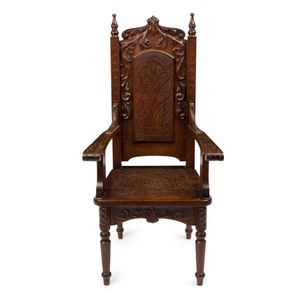Antique French Gothic Oak Hall Chairs
You must be a subscriber, and be logged in to view price and dealer details.
Subscribe Now to view actual auction price for this item
When you subscribe, you have the option of setting the currency in which to display prices to $Au, $US, $NZ or Stg.
- Oak - Native to Europe and England, oak has been used for joinery, furniture and building since the beginning of the medieval civilisation. It is a pale yellow in colour when freshly cut and darkens with age to a mid brown colour.
Oak as a furniture timber was superceded by walnut in the 17th century, and in the 18th century by mahogany,
Semi-fossilised bog oak is black in colour, and is found in peat bogs where the trees have fallen and been preserved from decay by the bog. It is used for jewellery and small carved trinkets.
Pollard oak is taken from an oak that has been regularly pollarded, that is the upper branches have been removed at the top of the trunk, result that new branches would appear, and over time the top would become ball-like. . When harvested and sawn, the timber displays a continuous surface of knotty circles. The timber was scarce and expensive and was used in more expensive pieces of furniture in the Regency and Victorian periods. - Finial - An architectural decoration, found on the upper parts of of an object. On furniture they are usually found on pediments, canopies and shelf supports. On smaller ceramic or silver items, such as spoons, they may decorate the top of the item itself, or the lid or cover where they provide a useful handle for removal.
Finials have a variety of shapes and forms. They may be urn-shaped, baluster shaped round or spiral, but usually taper into an upper point. Many real life shapes may also be used as finials, such as pineapples, berries, pinecones, buds, lotus and acorns. Sometimes animals such as a lion are depicted, or fish and dolphins. - Ogee - A serpentine shape, usually convex at the upper part, concave at the lower. Mostly used to describe the front shapes of parts of carcass furniture, such as cornices, drawer fronts and feet.
- Gothic Style, Furniture - Gothic style furniture refers to pieces that are designed and crafted in the Gothic architectural and decorative style that was popular in Europe from the 12th to the 16th centuries. This style of furniture is characterised by its elaborate and ornate details, as well as its use of dark and heavy woods, such as oak and walnut.
Gothic style furniture often features intricate carvings and embellishments, including pointed arches, quatrefoils, and tracery. The style also frequently incorporates elements such as coats of arms, shields, and religious symbols. Gothic furniture often has a heavy and substantial appearance, and the pieces are often finished with a dark stain to accentuate the detailed carving and embellishments.
The furniture items can be quite large and imposing, and they are often used as statement pieces in large rooms. Gothic furniture can be a striking and dramatic addition to any space, and it is often appreciated by those who have an interest in medieval and historical design. - Bevel / Chamfer - In furniture making, a chamfered corner refers to a technique used to create a smooth, angled edge on the corner of a piece of furniture. This is typically done by cutting away a small portion of the corner at an angle, typically 45 degrees, creating a diagonal edge, rather than a sharp 90-degree angle. This technique can be used on various parts of a piece of furniture such as table legs, drawer fronts, or door frames. Chamfering can add visual interest to a piece and can help to soften the overall look of a piece of furniture. It is often used in conjunction with other techniques, such as rounding edges or using contrasting wood species to create a more elegant, sophisticated look. Chamfering is a simple way to add a touch of elegance to a piece of furniture and it is a common technique used by furniture makers.
This item has been included into following indexes:
-
chairs, singles / pairs / threes, style or period
- French 949
- hall 212
- Victorian, other styles 1,179
- chairs, singles / pairs / threes, timber - oak 488
Visually similar items

A French renaissance style oak cabinet supported on spiral turned legs having carved classical figure panels, 100 cm high, 69 cm wide, 38 cm deep

A carved oak wainscot chair, English 17th century, 123 cm high, 50 cm wide, 60 cm deep

A 17th century English oak joined armchair with a diamond panelled back below a concave nulled frieze, above scroll arms and turned legs with cross stretchers, initialled Eb to apron and Js to back, right arm loose.

School of Robert Prenzel carver chair, blackwood, early 20th century decorated with carved orchids monogram and dated 'E.Y.C. 6th Sept. 1904' 53 cm across the handles
